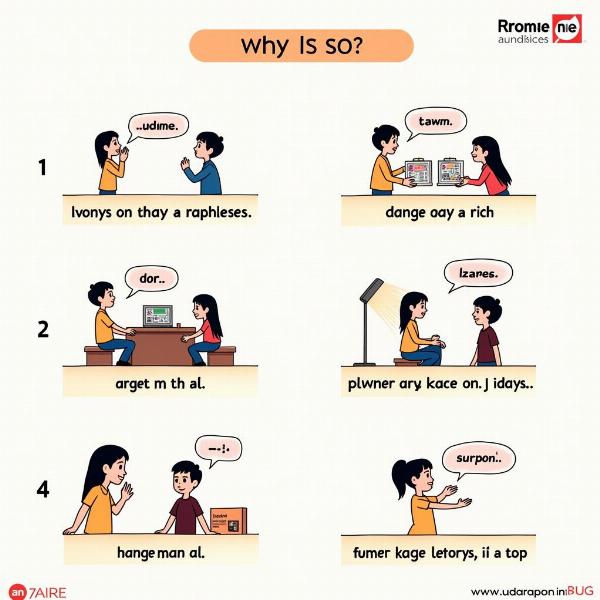Understanding the nuances of Hindi, especially when translating phrases like “why is it so,” can be tricky. Direct translations often miss the subtle meanings and cultural context embedded in everyday Hindi conversation. This article explores the various ways to express “why is it so” in Hindi, taking into account the situation, formality level, and emotional undertones.
Exploring the Different Ways to Say “Why Is It So” in Hindi
There isn’t one single perfect translation for “why is it so” in Hindi. The best choice depends on the specific context. Are you asking about a fact, a situation, or someone’s behavior? Is the tone inquisitive, surprised, or perhaps frustrated?
- क्यों ऐसा है? (Kyon aisa hai?): This is the most literal translation and is generally suitable for most situations. It translates directly to “why is it like this?” and is a good starting point for expressing general curiosity.
- ऐसा क्यों है? (Aisa kyon hai?): This variation is also common and carries a similar meaning. The word order is slightly different, but the meaning remains essentially the same.
- ये क्यों है? (Yeh kyon hai?): This phrase is more direct and often used when pointing to a specific object or situation. It translates to “why is this?”
- कैसे हुआ? (Kaise hua?): This phrase focuses on how something happened, rather than why. It’s useful when inquiring about the process or events leading to a particular situation.
- क्या बात है? (Kya baat hai?): This translates to “what’s the matter?” and is often used to express surprise or concern. While not a direct translation of “why is it so,” it’s a common way to ask about an unusual situation.
Choosing the Right Phrase for the Right Situation
Using the correct phrase demonstrates your understanding of Hindi and avoids misunderstandings. Let’s look at some examples:
- Formal situations: In formal settings, using “क्यों ऐसा है? (Kyon aisa hai?)” or “ऐसा क्यों है? (Aisa kyon hai?)” is generally appropriate.
- Informal conversations: With friends and family, you can use more colloquial phrases like “क्या बात है? (Kya baat hai?)” or even shorter forms like “क्यों? (Kyon?)” meaning simply “why?”.
- Expressing surprise: “क्या बात है? (Kya baat hai?)” effectively conveys surprise or disbelief.
- Inquiring about a process: Use “कैसे हुआ? (Kaise hua?)” when you want to know how something came to be.
 Examples of Hindi Conversations
Examples of Hindi Conversations
Delving Deeper into Cultural Context
Understanding the cultural context behind these phrases is crucial. Indian culture often emphasizes politeness and respect, especially towards elders. The tone of voice and body language play a significant role in conveying your intended meaning.
What Happens When You Mistranslate?
Mistranslating “why is it so” can lead to confusion or even offense. For example, using a direct translation in a formal setting might sound abrupt or disrespectful. Similarly, using an overly casual phrase with an elder could be considered impolite.
Conclusion: Mastering the Nuances of “Why Is It So” in Hindi
Mastering the different ways to say “why is it so” in Hindi requires more than just memorizing translations. It involves understanding the subtle nuances of the language and the cultural context in which it’s used. By paying attention to these details, you can communicate effectively and avoid potential misunderstandings. Remember, choosing the right phrase demonstrates your respect for the language and the culture.
FAQ
- What is the most common way to say “why is it so” in Hindi? क्यों ऐसा है? (Kyon aisa hai?) is the most common and generally accepted translation.
- Is it okay to simply say “Kyon?” in Hindi? Yes, in informal settings with close acquaintances, “Kyon?” (meaning “why?”) is acceptable.
- How do I ask “why is it so” in a polite way? Using क्यों ऐसा है? (Kyon aisa hai?) or ऐसा क्यों है? (Aisa kyon hai?) with a respectful tone is considered polite.
- What if I want to ask about the process, not the reason? Use कैसे हुआ? (Kaise hua?) which means “how did it happen?”
- How do I express surprise in Hindi along with asking “why is it so”? क्या बात है? (Kya baat hai?) is a great way to convey surprise and inquire about the situation.
- Can the word order change the meaning in Hindi? While slight variations in word order are common, they generally don’t significantly alter the core meaning.
- How important is tone of voice when asking “why is it so” in Hindi? Tone of voice is crucial, especially in a culture that emphasizes politeness and respect.
Meaning-Hindi.in specializes in accurate and culturally sensitive Hindi translations, covering a wide range of services from business and legal documents to website localization and educational materials. We understand the subtle nuances of the Hindi language and ensure your message is conveyed correctly. Need expert Hindi translation services? Contact us at [email protected] or call us at +91 11-4502-7584. Meaning-Hindi.in offers professional translation solutions tailored to your specific needs.